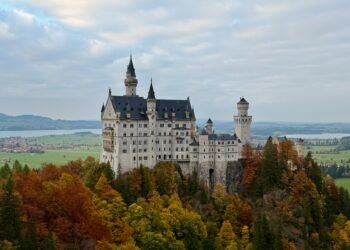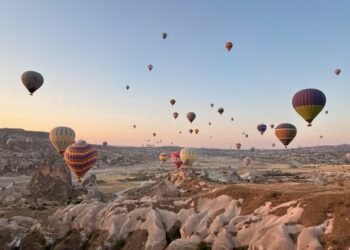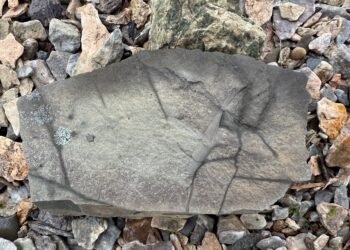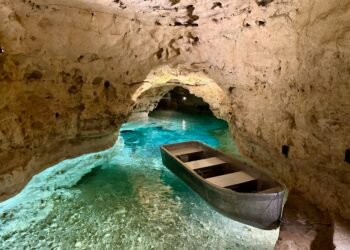1 Visiting Mer de Glace: Journey to France’s Largest Glacier
Tucked high in the French Alps above Chamonix, the Mer de Glace glacier offers more than stunning alpine views—it’s a front-row seat to Earth’s changing climate. Reached by a historic cogwheel railway, this massive river of ice once symbolized permanence. Today, it tells a more urgent story. From its dazzling ice cave to the visible scars of melting, Mer de Glace is both a marvel of geology and a cautionary tale of retreat. In this science travel guide, I’ll take you through the glacier’s natural history, climate impact, and what it’s like to visit this disappearing giant.
It all began as the bus I took from Lyon started its ascent toward the towering peaks of the French Alps. The sprawling countryside slowly gave way to rugged terrain, and in the distance, I caught my first glimpses of the jagged, snow-covered mountains. I felt a palpable sense of excitement building within me. The Mer de Glace glacier—a place I had read about, dreamed about—was finally within reach.
I had planned this trip to Chamonix in October, just after the busy tourist season. With fewer crowds around, I hoped to truly connect with the natural wonders of the Mont Blanc region. My mind wandered back to the pandemic when I spent time learning about the Mer de Glace from travel documentaries. This was, however, not my first introduction to this natural wonder, as I had seen photos of it before in articles and documentaries about climate change. The images of the glacier winding through a dramatic valley were imprinted in my mind, and I knew that witnessing it in person would be even more impressive than I could ever imagine.

I had never stood face to face with a glacier before, although I had glimpsed one from a distance in Interlaken, Switzerland, during a visit to Jungfraujoch. This trip, however, was different. I was determined not only to see the Mer de Glace, but to touch it, to feel the chill of ancient ice on my fingertips, and to understand the science behind its slow retreat.
2 What Is Mer de Glace? France’s Largest Glacier Explained
Mer de Glace, or “Sea of Ice,” is the largest glacier in France and one of the most accessible in the Alps. Flowing down the northern slopes of the Mont Blanc massif, this glacier stretches approximately 7 kilometers in length and reaches 200 meters in thickness at its deepest points.
It’s formed by the confluence of several smaller glaciers—including the Glacier du Tacul and Glacier de Leschaux—and slowly descends the Montenvers valley like a frozen river. What makes Mer de Glace especially unique is its dynamic nature: while it may seem solid and still, it’s constantly in motion, flowing downhill at a rate of about 90 meters per year.
For centuries, this glacier has captivated scientists, mountaineers, and travelers alike. It’s both a powerful symbol of nature’s grandeur and a real-time indicator of climate change. Once visible from Chamonix, it has now receded significantly—so much so that visitors must take a gondola and descend hundreds of steps to reach the ice.
3 Quick Facts
- Location: Mont Blanc Massif, French Alps, near Chamonix, France
- Length: ~7.5 km (4.7 miles) — France’s longest glacier
- Formation: Fed by several glaciers, including Géant, Leschaux, and Talèfre
- Flow Speed: Around 90 meters (295 feet) per year
- Name Meaning: “Sea of Ice” in French
- Scientific Interest: A key site for climate change research and glaciology
- Accessibility: Reachable by the historic Montenvers Railway since 1908
- Climate Impact: The glacier has lost ~100 meters of thickness since the early 1900s
- Most Popular Access: Via Montenvers cogwheel train from Chamonix
- Highlight: Annual Ice Cave carved into glacier (Grotte de Glace)
4 Taking the Mer de Glace Train: Scenic Journey from Chamonix
One of the most iconic ways to reach Mer de Glace is via the Montenvers cogwheel railway, which departs from the Gare du Montenvers station in Chamonix. The bright red train climbs over 800 meters of elevation in about 20 minutes, offering stunning alpine views along the way.

Trains typically leave every 30 minutes, but schedules vary by season. When I visited in October, the last train back from the glacier station departed at 5:00 PM—and it was completely full. If you’re planning to hike or explore the area, make sure to return to Gare du Montenvers Mer de Glace station at least 30 minutes early to guarantee a seat.

A round-trip ticket costs €35.50, and you can purchase them at the kiosks at the Chamonix station or online in advance.
As the train pulled into the mountaintop station at 1,913 meters (6,276 feet), I stepped out onto the observation deck—and was completely awestruck. The Mer de Glace glacier snaked through the valley below, framed by the towering Mont Blanc massif. From that vantage point, you can see not only the glacier’s path, but also the signs of its retreat etched into the landscape.

The observation terrace offers some of the best views in the region, perfect for photos or simply soaking in the immensity of the Alps. From here, you can continue on to the ice cave, a short gondola ride and stair descent away.
5 Touching the Mer de Glace Glacier
Reaching the valley floor, I finally had the opportunity to touch the ice. After all this time, I had finally come face to face with a glacier. The cool, smooth surface of the ice was otherworldly. This ice had potentially formed centuries ago, high up on Mont Blanc, and had slowly made its way down to this point. Touching it, I couldn’t help but think about the time it represented—the ancient snowfalls, the passing centuries, the slow crawl of ice through the valley.
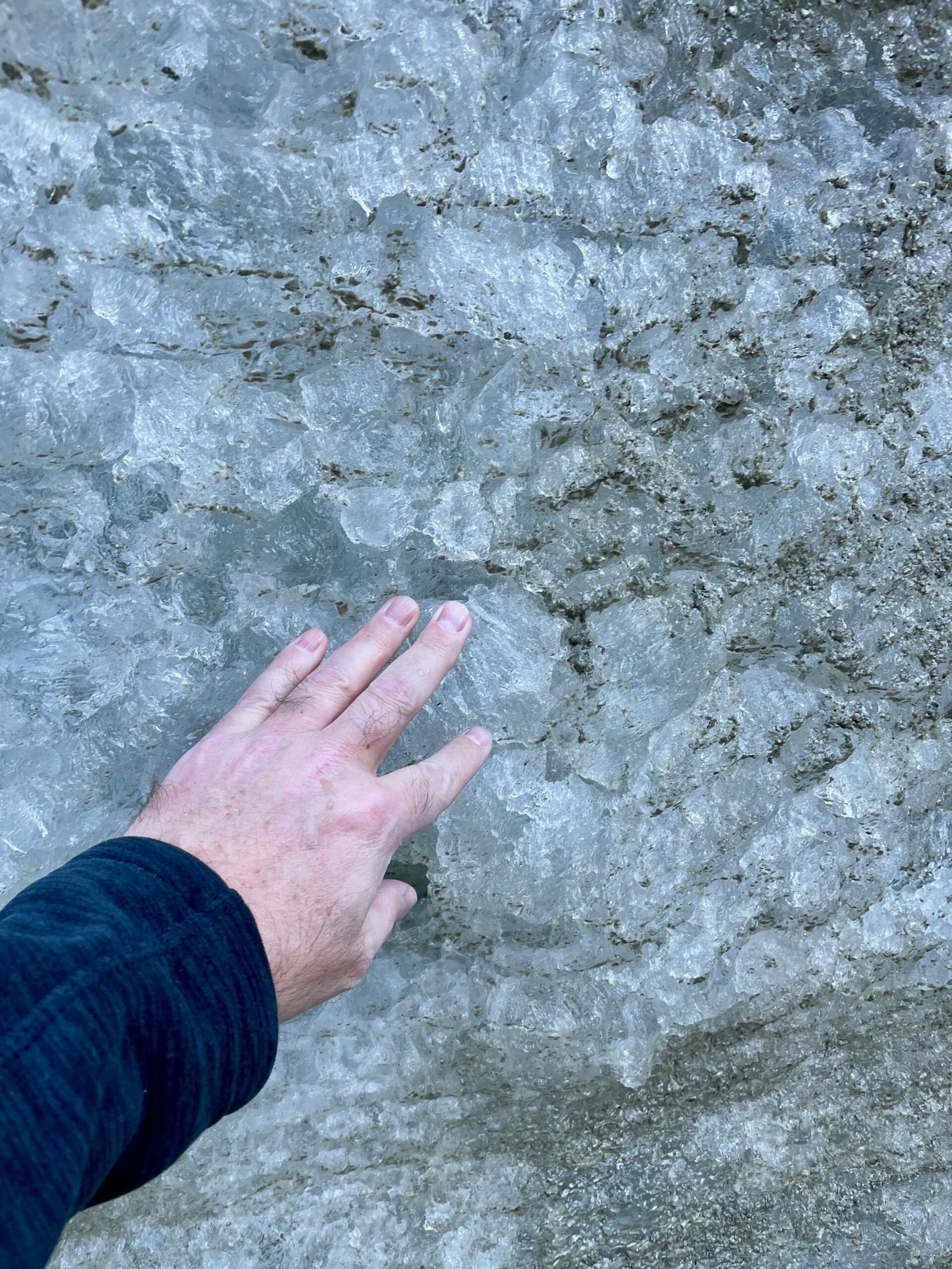
I sat down to rest near one of the glacier’s markers and reflected on the experience. It was astonishing to think how much the glacier had receded even in my lifetime. I thought back to all the news articles and reports I had read about climate change over the years. Standing here, in front of the Mer de Glace, those reports became much more than abstract ideas—they were real, tangible, and undeniable. The glacier’s retreat wasn’t just happening in some faraway place. It was happening right in front of me.
6 Inside the Ice Cave: A Walk Through Time
Each year, a new tunnel is carved into the glacier to form the Grotte de Glace, or Ice Cave—a surreal experience that allows visitors to literally walk inside the Mer de Glace. The tunnel stretches deep into the ice, revealing shimmering blue walls, embedded bubbles, and layers that formed over centuries. Inside, illuminated sculptures and frozen chambers give the experience a cathedral-like stillness.

Beyond its visual beauty, the ice cave offers a firsthand look at glaciology in action. The stratified walls expose annual snowfall cycles compacted into glacial ice, allowing science-minded visitors to observe layers of time preserved beneath their feet. It’s a rare opportunity to see the inner anatomy of a living glacier.

When I visited, the main ice cave was unfortunately closed to the public. Still, I was able to explore the face of the glacier and approach smaller ice formations nearby. One smaller ice tunnel shimmered with a soft, blue glow and gave a haunting glimpse into the glacier’s interior. While I missed the main exhibit, the experience of standing so close to this ancient ice—and witnessing its slow melt—was unforgettable.
7 The Alps: A Geological Masterpiece
The glacier exists within a geological masterpiece—the Mont Blanc massif, the highest mountain range in the Alps. The story of the Alps dates back over 100 million years when tectonic plates began to collide. The African and Eurasian plates converged, pushing the Earth’s crust upward and creating the towering peaks we see today. The mountains are still rising, albeit slowly, as the tectonic activity continues to shape the landscape.
As I stood on the edge of this ancient valley, I couldn’t help but be in awe of the forces that had created it. The rugged peaks around me were sharp, almost defiant, as if the Earth had split open and thrust them into the sky. The valley through which the Mer de Glace flows was sculpted by these tectonic movements, and over the millennia, glaciers like Mer de Glace have further shaped the landscape, carving deep valleys and leaving behind polished rock and moraines.

The evidence of this glacial sculpting was all around me. The bedrock beneath the glacier was smooth, almost glass-like, where the ice had scraped across it, dragging stones embedded in the glacier’s belly. These scars in the rock told the story of millions of years of erosion, a story that continued to unfold with each passing day.
“Standing at the foot of Mer de Glace, I wasn’t just witnessing a glacier—I was seeing a tangible reminder of how much our world has changed in just a few decades.”
8 Climate Change and the Disappearing Ice
But this story isn’t just about the past—it’s about the future. The Mer de Glace is retreating, and its decline is accelerating. As I hiked down toward the glacier, I passed markers indicating where the glacier had been at various points in time. These signs stood as silent witnesses to the glacier’s retreat. One particularly poignant marker indicated the glacier’s height in 1990 – the year I graduated from high school. Since then, the glacier has receded dramatically.

Today, the Mer de Glace retreats at a rate of 40 to 80 meters per year. Scientists have warned that if current trends continue, glaciers like Mer de Glace may vanish entirely in the not-too-distant future. Climate change is driving this accelerated melting. Rising global temperatures, fueled by human activity, are causing glaciers to melt faster than they can be replenished by snowfall. This is not just a problem for the Mer de Glace. Glaciers around the world—from the Andes to the Himalayas—are shrinking, threatening water supplies, ecosystems, and even the livelihoods of people who depend on glacial meltwater.
View this post on Instagram
Standing in front of the Mer de Glace, I felt an overwhelming sense of loss. This glacier, which had taken centuries to form, was disappearing within the span of a few decades. The evidence was all around me—the glacier’s surface was fractured and broken, its once-mighty flow reduced to a small stream of ice winding through the valley.

9 Practical Tips for Visiting the Mer de Glace
- Timing Matters: October is a fantastic time to visit to avoid the peak summer crowds, but be prepared for cooler temperatures and shorter daylight hours.
- Getting to Chamonix: I flew into Paris, took a train to Lyon Saint-Exupéry, and then a bus to Chamonix. The journey through the French Alps is breathtaking.
- Cogwheel Train Ride: The scenic cogwheel train ride from Chamonix to Gare du Montenvers costs €35.50 round trip per person. The last train departs at 5:00 pm in October, so plan your hike accordingly.
- Hiking to the Glacier: If you’re up for an adventure, the hike to the glacier takes about 30 minutes down and an hour back up. Bring plenty of water and wear sturdy shoes.
- The Grotte de Glace: While the famous ice cave may be closed at times, there are smaller ice formations along the glacier face to explore.
- Dining Options: There’s a restaurant at Gare du Montenvers, so you can grab a snack or a drink with a view of the glacier.
10 Pro Tips for the Science Traveler
- Visit the Glaciarium for a Deeper Understanding of Glacier Science
Before you embark on your journey down to the Mer de Glace, spend time at the Glaciarium exhibition near the Gare du Montenvers station. This small but informative museum covers the formation and movement of glaciers, the impact of climate change, and the history of glaciology. It provides essential scientific context for what you’ll witness firsthand at the glacier. - Take Note of the Glacier Markers for a Climate Change Perspective
As you descend toward the glacier, pay special attention to the markers that show where the glacier stood in different years. Each marker serves as a visual reminder of the glacier’s retreat, with dramatic differences especially in recent decades. Compare these markers to your lifetime milestones for a deeply personal reflection on climate change. - Bring a Geological Field Notebook
If you’re passionate about geology, bring a field notebook to jot down observations. As you hike down to the glacier, take note of the exposed bedrock and the striations left behind by the glacier’s movement. These glacial scars offer a textbook case study of erosion and the geological forces that shape mountain ranges. - Schedule a Guided Tour with a Glaciologist
For those particularly interested in the science of glaciers, consider scheduling a guided tour with a local glaciologist. Some tour operators in Chamonix offer specialized scientific tours, providing deeper insights into the glacier’s formation, movement, and retreat. These tours often include access to areas of the glacier not typically visited by tourists. - Visit the Aiguilles Rouges Nature Reserve
Extend your stay with a visit to the nearby Aiguilles Rouges Nature Reserve. This high-altitude reserve is home to a range of Alpine species and offers stunning views of the Mer de Glace from different angles. Science travelers can study Alpine flora and fauna, adding a biological dimension to their glacier experience. It’s also a fantastic spot for birdwatching, especially for rare species like the golden eagle.
11 Personal Reflection: A Glimpse of Our Changing World
As I stood at the face of the Mer de Glace, touching the ice that had traveled down from the heights of Mont Blanc decades ago, a sense of awe and sorrow washed over me. The glacier itself was magnificent—a vast river of frozen time, each layer of ice holding stories of the past. But beneath the wonder, there was an undeniable weight to the experience. I had come to witness a natural marvel, but what I found was also a living reminder of our planet’s fragility.
In the quiet moments as I sat near one of the glacier markers, I found myself reflecting on how rapidly the world is changing. The glacier had once filled this valley, its ice stretching to heights unimaginable today. Now, it was shrinking—retreating year by year, meter by meter. As someone who had read about climate change for years, I knew the science. But seeing it in person, standing at the very edge of a glacier that is literally disappearing in my lifetime, brought the reality home in a way that no news article or documentary could.

The markers I passed told a story that was both deeply personal and global. As I mentioned before, the 1990 marker stood out to me—the year I graduated from high school. In those decades, so much had changed, not just in my own life but for the glacier, and by extension, for the planet. Climate change isn’t just a headline; it’s happening right now, in real places, to real natural wonders. I couldn’t help but feel a profound sense of urgency. What other parts of the world, what other glaciers, forests, and ecosystems, will be unrecognizable within my lifetime?
Witnessing the retreat of the Mer de Glace was both a privilege and a heartbreak. It was a privilege to experience such an awe-inspiring landscape and to touch the ancient ice, to stand on a valley carved by nature over millennia. But it was heartbreaking to know that future generations might never experience it the same way. The reality of climate change hit hard here—it’s not just about numbers or far-off consequences; it’s happening now, before our eyes.
As I hiked back up to the train station, I couldn’t stop thinking about what I had seen. The Mer de Glace is just one glacier, but it symbolizes a much larger issue. It made me think deeply about my role in the world—what I can do to be part of the solution. This trip, which I had originally planned as an adventure, turned into something much more significant: a reminder that the natural beauty we cherish needs our protection. If we want future generations to experience the same wonders, we need to act now, before it’s too late.
In the end, my visit to Mer de Glace was not just a journey through the Alps—it was a journey into the heart of one of the most pressing issues of our time. The beauty and fragility of this place left a lasting impression—one that I’ll carry with me long after the chill of the glacier has faded from my fingertips.
If you’d like to explore more incredible glacial environments and learn how they’re being impacted by climate change, I invite you to read about my winter adventure at Sólheimajökull Glacier in Iceland. In that article, I share my experiences navigating its dramatic landscapes, discuss the environmental challenges it faces, and offer tips for exploring this icy wonder responsibly.
12 More Science Travel Adventures
If you enjoy exploring the crossroads of science, nature, and culture, here are a few more of my favourite science travel experiences:


